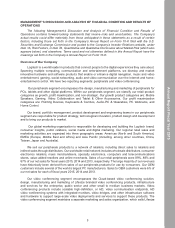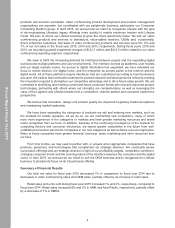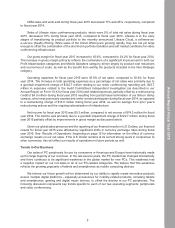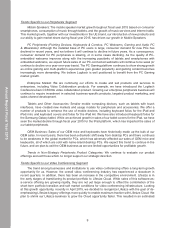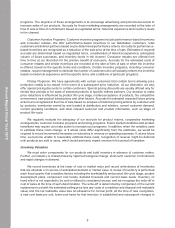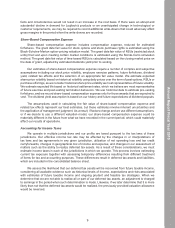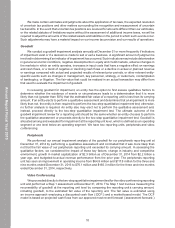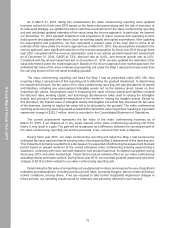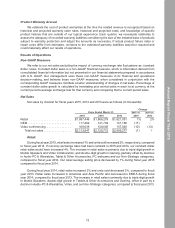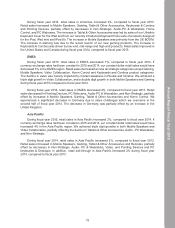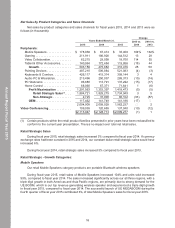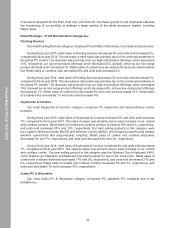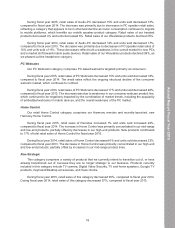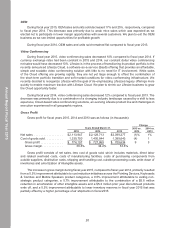Logitech 2015 Annual Report Download - page 127
Download and view the complete annual report
Please find page 127 of the 2015 Logitech annual report below. You can navigate through the pages in the report by either clicking on the pages listed below, or by using the keyword search tool below to find specific information within the annual report.
developed in connection with the video conferencing reporting unit to perform the goodwill impairment
assessment. The assessment forecast is based on a number of key assumptions, including, but not
limited to, discount rate, compound annual growth rate (“CAGR”) during the forecast period, and terminal
value. The terminal value is based on an exit price at the end of the assessment forecast using an earning
multiple applied to the final year of the assessment forecast. The discount rate is applied to the projected
cash flows to reflect the risks inherent in the timing and amount of the projected cash flows, including
the terminal value, and is derived from the weighted average cost of capital of market participants in
similar businesses. The market approach is based on applying certain revenue and earnings multiples
of comparable companies relevant to each of its reporting units to the respective revenue and earnings
metrics of our reporting units. The income approach and the market approach require the exercise of
significant judgment, including assumptions about appropriate discount rates, long-term growth rates for
purposes of determining a terminal value at the end of the discrete forecast period, economic expectations,
timing of expected future cash flows, and expectations of returns on equity that will be achieved. Such
assumptions are subject to change as a result of changing economic and competitive conditions. If the
carrying amount of the reporting unit exceeds its fair value as determined by these assessments, goodwill
is considered impaired and the Step 2 test is performed to measure the amount of impairment loss.
The Step 2 test measures the impairment loss by allocating the reporting unit’s fair value to its assets,
including unrecognized intangibles which are not carried on the books, and liabilities other than goodwill,
and comparing the resulting implied fair value of goodwill with its carrying amount. The implied fair value
of goodwill is the excess of the fair value of the reporting unit over the fair value amounts assigned to all
of the assets and liabilities of that unit as if the reporting unit was acquired in a business combination
and the fair value of the reporting unit represented the purchase price. If the carrying value of goodwill
exceeds its implied fair value, an impairment loss equal to such excess would be recognized.
We use a third party valuation expert in the development of our market and income approach
models. The annual Step 1 assessment performed as of December 31, 2014 resulted in us determining
that the video conferencing reporting unit passed the Step 1 test because the estimated fair value of video
conferencing reporting unit from the Step 1 assessment exceeded its carrying value by approximately
38.0%, thus not requiring a Step 2 assessment of this reporting unit. Therefore, we concluded it was
more likely than not that the goodwill of the video conferencing reporting unit was not impaired as of
December 31, 2014.
During the fourth quarter of the fiscal year ended March 31, 2015, the net sales of the video
conferencing reporting unit decreased to $24.9 million from $31.0 million in the fourth quarter of the fiscal
year ended March 31, 2014 and from $29.9 million in the third quarter of fiscal year ended March 31, 2015.
The sales decline was concentrated in the video conferencing infrastructure legacy business primarily
due to faster shift of customer preference towards Cloud infrastructure conferencing versus on-premise
infrastructure solutions and resource realignment, which was not anticipated during annual impairment
assessment as of December 31, 2014. This quick shift towards Cloud-based offering resulted in the change
in business strategy to de-emphasize Lifesize’s legacy offerings more quickly than planned to enable
maximum traction of the Lifesize Cloud, which would result in shrinking the legacy Lifesize business but
could grow the Cloud opportunity faster. In the last nine months, the sales of Cloud-based offerings have
grown rapidly; however, they are not yet large enough to offset the combination of the short-term portfolio
transition. As a result of the lower-than-expected performance in the legacy infrastructure sales, we made
a strategic decision to sharpen our focus on our new Cloud-based offering. We plan to realign our costs
and operations to this new strategy as part of a restructuring plan announced during April 2015 and are
exploring various other options for our Lifesize business. The significant change in business strategy has
adversely affected the near-term projections and we expect that it will shrink the Lifesize revenue for the
next several years, including lowering the overall growth, pushing out the break-even point and increasing
the operating loss as well as increasing uncertainty in the near term. In light of the aforementioned, we
concluded it was appropriate to perform the Step 1 goodwill impairment assessment.
11
Annual Report Fiscal Year 2015




